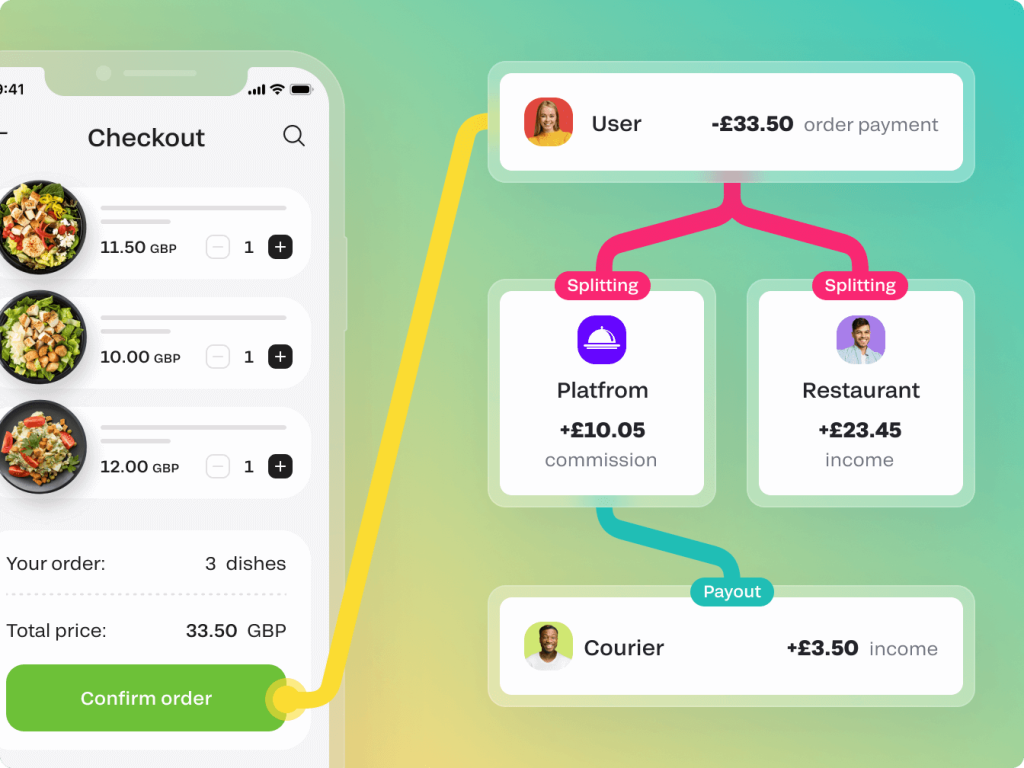If there’s a topic we’ve missed, let us know, and we will be happy to dive into it.
- How to create, build, set up, and start a crowdfunding platform with expert insights & Fondy’s payment solutions
- App vs platform: discover the difference between an application and a platform for business with Fondy’s solutions
- Simplify B2C payouts for marketplaces and the gig economy with Fondy
- Flexible payout schedules and seamless settlement payouts for two-sided platforms
- Boost your growth with automated payouts by implementing payout automation on your platform
- International payouts with our innovative system for two-sided platforms
- Product vs Platform: exploring the benefits and choosing the right payment solution
- How to accept payment on marketplaces: a guide to streamline your platform
- How to create a platform: step-by-step guide for building an online success
- What is an online platform or marketplace platform: key insights & payment solutions
- How does marketplace work: a focus on online payments and payouts
- How to create a marketplace website with payment solutions designed to build growth
- Ecommerce Platform vs Marketplace: key differences and how to choose the right payment solution
- What is a SaaS platform: meaning, examples, and payment solutions to boost their performance
- The role of advanced APIs in enabling seamless payment flows for MedTech innovators
- Maximising positive impact: the synergy of AI, sustainability, and comprehensive payment solutions
- Deconstructing payment processing
- How to accept payments on social networks?
- What are the best payment gateways for WooCommerce?
- What is the best payment gateway for marketplaces and platforms?
How to create a platform: step-by-step guide for building an online success

Introduction
When individuals begin to explore how to create a platform and enter the online marketplace, they often imagine it as a smooth journey from idea to success. Yet the truth is that constructing a thriving online presence involves thoughtful planning, careful execution, and an ability to adapt as the project grows.
The objective is not simply to launch a website or piece of software, but rather to create a self-sustaining ecosystem where value travels between different parties. Understanding how to build an online platform means learning how each component interacts with the next, from conceptualisation through to payment processes and sustained growth over time.
This guide will walk through the core foundations of creating and managing a platform, exploring the importance of structure, user engagement, technical features, payment solutions, and long-term scalability. By the end, the aim is to ensure that any reader who wishes to create an online platform has a clear picture of the journey ahead, the key considerations at each step, and a better understanding of how to position themselves for a lasting competitive advantage in the digital business world.
What is an online platform?
How to create a platform begins with defining precisely what a platform is. Although the term is widely used, not everyone shares a concrete understanding of what distinguishes a platform from a standard website or application.
A platform is not just a digital storefront or a simple marketplace; it is a structured environment that facilitates interactions, exchanges, and relationships between two or more groups. Instead of a one-directional offering, it encourages a continuous flow of value.
Users might exchange services, share content, or transact with one another, while the platform itself serves as the intermediary that brings them together. Creating a platform can mean building something as global as an online marketplace connecting buyers and sellers in multiple regions, or something more niche, like a specialised hub for professionals in a particular industry.
Whether it is consumer-focused or B2B, a platform thrives by carefully balancing the needs of all participants, encouraging trust, and simplifying user journeys through intuitive interfaces.
You can read more about this in our article:
“What is an online platform or marketplace platform: key insights & payment solutions“.
Why create an online platform?
It is equally important to clarify why anyone would seek to build such a structure. Many entrepreneurs attempt to build an online platform because it allows the formation of digital communities that scale beyond geographic limits.
A robust platform can connect diverse user bases, enabling them to meet their needs more effectively than if they were operating in isolation. Creating a platform can also allow entrepreneurs to tap into growing online trends, from remote working and gig economies to frictionless e-commerce.
This environment often leads to greater user retention, as people appreciate the convenience of a one-stop solution. It can also open up multiple streams of revenue, since platform owners can charge subscription fees, take commissions from transactions, or sell premium features.
In an increasingly digital business landscape, a successful platform can become a powerful asset that endures market shifts and accelerates growth. As more companies pivot to online models, learning how to build an online platform offers a significant competitive edge.

Step-by-step guide: how to build an online platform
Step 1: define your purpose
Before starting to create any code or hire developers, it is important to refine the core concept. One must understand the platform’s overarching goal, its target audience, and the unique value it intends to provide.
Is the objective to create a collaborative workspace, a marketplace for freelancers, a property rental system, or a digital learning environment? Clarity at this stage ensures that all subsequent decisions align with a coherent vision.
Step 2: identify your participants
Every platform involves at least two groups interacting, such as service providers and customers. Identifying these groups and understanding their needs and pain points informs the platform’s key features.
By conducting research and talking to potential users, it becomes easier to shape a product that genuinely addresses their challenges. Without a clear grasp of who will use the platform and why, it is impossible to create a meaningful and sustainable online ecosystem.
Step 3: choose your technology approach
Some entrepreneurs prefer to build everything from scratch, while others rely on existing frameworks or platform-as-a-service solutions. The choice depends on factors like budget, timeline, and the complexity of the required features.
The ultimate aim is to ensure flexibility, security, scalability, and ease of integration with payment systems. By selecting the right technology stack, the platform can adapt as it grows, meet evolving user expectations, and respond to new market trends without incurring excessive rework or downtime.
Step 4: integrate robust payment options
As soon as the basic structure takes form, it becomes essential to consider payment solutions. Platforms often revolve around transactions, and providing secure, transparent, and flexible payment methods builds trust.
Offering multiple payment options, including cards, local bank transfers, or internationally recognised digital solutions, can greatly enhance user confidence. Multi-currency support, mobile-optimised checkouts, and a seamless payout process further differentiate a platform from basic online services.
Partnering with a fintech solution designed for two-sided platforms makes it easier to handle these complexities, including automated seller onboarding and compliance checks.
Step 5: develop an intuitive user interface
It is important to create a platform interface that feels natural to users. Navigation should be clear, so visitors can find what they need without unnecessary obstacles.
A user-friendly design encourages trust and long-term engagement. Responsive layouts ensure accessibility on various devices, while thoughtful branding and consistent messaging align with the platform’s value proposition.
The result is a setting in which users feel comfortable exploring, interacting, and returning to carry out future transactions or collaborations.
Step 6: launch and refine
After careful planning, prototyping, and testing, the time comes to launch. It is often wise to begin with a limited release, focusing on a specific region or a small group of early adopters.
This approach allows the platform to gather valuable feedback, identify improvements, and build stronger foundations. Over time, as insights emerge, features can be refined, user engagement strategies adjusted, and the platform’s presence expanded.
Launching is not the end; it is the start of an ongoing journey to make the platform better suited to evolving user needs and market dynamics.
Common challenges in platform development

Another significant aspect is recognising the challenges that may arise along the way. Balancing supply and demand is often difficult, requiring creative marketing, incentives, and engagement strategies.
Compliance and security also demand attention, as users need to trust that their data and finances are safe. Implementing strong encryption and ensuring adherence to data protection standards lays a solid foundation for long-term credibility.
By anticipating these issues, platform owners can tackle them head-on, turning potential setbacks into opportunities for further refinement.
By the way, what is the business direction of your future platform? For example if you are planning to build a crowdfunding platform, we have a ready-made guide on this topic: “How to create, build, set up, and start a crowdfunding platform”. This in-depth resource covers everything from essential platform features and compliance considerations to advanced payment integrations designed specifically for two-sided crowdfunding models. Whether you’re exploring crowdfunding for the first time or refining an existing idea, you’ll find step-by-step advice and real-world insights to help you navigate each stage of the process, ensuring a seamless experience for both creators and contributors.
How payment solutions drive platform success
Payments form the backbone of many platforms. Transparent pricing, secure checkouts, and reliable multi-currency support not only facilitate transactions but also shape user perceptions.
A platform that simplifies payments builds trust, encouraging users to return and recommend it to others. Real-time analytics and reporting enable informed decision-making, allowing platform owners to optimise user experiences and monetisation strategies.
Whether it is recurring billing, splitting revenues among multiple parties, or handling instant payouts, a well-structured payment system is essential.
Why choose Fondy for your online platform
For those seeking a partner that understands the complexities of running a two-sided platform, Fondy Flow offers a comprehensive fintech solution. Transparent pricing, no hidden charges, and cloud infrastructure that can scale at pace ensure that even sudden traffic spikes do not compromise performance.
Fondy supports diverse payment methods, from cards and digital wallets to BNPL options, catering to a global user base. Multi-currency acceptance, embedded checkouts, and automated seller onboarding further simplify the financial workflow.
This approach leaves platform owners free to focus on delivering value to users, knowing that compliance, mass payouts, and transaction management are handled by a trusted partner.
Conclusion: build your platform with the right tools and with Fondy
When considering how to create a platform that achieves online success, the process involves careful planning, clear objectives, and continuous refinement.
From defining the platform’s purpose and identifying participants to integrating robust payment solutions and developing an intuitive interface, each step paves the way for long-term viability. Over time, by aligning with a reliable fintech partner like Fondy Flow, platform owners can streamline operations, adapt to evolving market conditions, and nurture an environment where both providers and users thrive.
By doing so, building an online platform becomes a strategic investment in online business growth, rather than a daunting challenge.